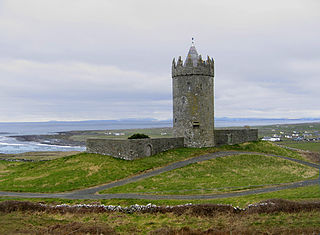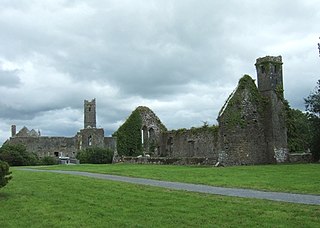
Knock is a village in County Mayo, Ireland. Its notability is derived from the Knock Shrine, an approved Catholic shrine and place of pilgrimage where the faithful believe that the Blessed Virgin Mary, Saint Joseph and Saint John the Evangelist appeared on 21 August 1879. In the 20th century, Knock became one of Europe's major Catholic Marian shrines, alongside Lourdes and Fatima. One and a half million pilgrims visit Knock Shrine annually. Pope John Paul II, a supporter of devotion to the Virgin Mary, visited Knock in 1979 to commemorate the centenary of the apparition. Knock is also a civil parish in the ancient barony of Costello.

Kilfenora is a village and a civil parish in County Clare, Ireland. It is situated south of the karst limestone region known as the Burren. Since medieval times when it was the episcopal see of the Bishop of Kilfenora, it has been known as the "City of the Crosses" for its seven high crosses. The village had around 220 inhabitants in 2011. Much of the TV show Father Ted (1995–98) was filmed there.

Doonagore Castle is a round 16th-century tower house with a small walled enclosure located about 1 km south of the coastal village of Doolin in County Clare, Ireland. Its name may be derived from Dún na Gabhair, meaning "the fort of the rounded hills" or the "fort of the goats". Doonagore Castle is at present a private holiday home, inaccessible to the public.

Doora is a civil parish and village in County Clare, Ireland, just to the east of the town of Ennis. It is part of the Catholic parish of Doora Barefield. Parts of Doora are contained in the town of Ennis.

Kildysart, officially Killadysert, is a village in County Clare, Ireland and a civil and Roman Catholic parish by the same name that surrounds the village.
The Colleen Bawn, or The Brides of Garryowen is a melodramatic play written by Irish playwright Dion Boucicault. It was first performed at Laura Keene's Theatre, New York, on 27 March 1860 with Laura Keene playing Anne Chute and Boucicault playing Myles na Coppaleen. It was most recently performed in Dublin at the Project Arts Centre in July and August 2010 and in Belfast by Bruiser Theatre Company at the Lyric Theatre in April 2018. Several film versions have also been made.

Ballynacally is a village and townland situated 16.7 km (10.4 mi) southwest of Ennis, on the R473 coast road to Kilrush in the civil parish of Kilchreest, County Clare, Ireland. It lies near the bank of the River Shannon.

Quin is a village in southeast County Clare in Ireland and a Catholic parish and civil parish of the same name. The main attraction, Quin Abbey, is open to the public, and although mostly ruined, much of the structure remains. The abbey was built on the foundations of an earlier Norman castle, and the foundations of three corner towers can still be seen. The name of the village is a reference in ancient Irish to the original five roads out of the village. The village is located in a district sometimes known as Plassey.

Glin is a village in the northwest of County Limerick, Ireland. It is on the south shore of the River Shannon's estuary, on the N69 road between Foynes and Tarbert. The population of the village in 2006 was 566.

Kilkishen is a village in southeast County Clare, Ireland. The village is 8 kilometres (5 mi) east of Quin and 14 kilometres (8.7 mi) north of Shannon.

Spancill Hill or Spancilhill is a hill and adjacent dispersed settlement in County Clare, Ireland. The historic hamlet of Spancilhill was by the fair green, which is still the site of the Spancill Hill Fair, Ireland's oldest horse fair, which occurs annually on 23 June. Houses are concentrated slightly south at Cross of Spancilhill, where the R352 road between Ennis to the west and Tulla to the east crosses a local road between Barefield to the north and Quin to the south.

Killimer is a village in County Clare, Ireland, in a civil parish of the same name. It is located on the northern bank of the Shannon and the N67 which passes through the village.

Ballyhannon Castle is a medieval Irish castle dating back to the 15th century, located near the village of Quin in County Clare, on the west coast of Ireland. It is fully intact and in the Irish Governmental records it is registered as a National Monument and "Listed/Protected" structure, intended to protect its historic, architectural and aesthetic significance.

Moyasta is a hamlet in County Clare, Ireland, situated between Kilkee and Kilrush on the N67. The hamlet is bordered by the Moyasta River, flowing from the bogs to Poulnasherry Bay.

Killaloe is a civil parish in County Clare, Ireland. The main settlement is the town of Killaloe.

Kilmurry-Negaul is a civil parish and a village in County Clare, Ireland.

Killeely is a civil parish that lies partly in County Clare and partly in County Limerick in Ireland.

Kilfintinan is a civil parish in County Clare, Ireland. It is part of the Catholic parish of Cratloe.

Kilmanaheen is a civil parish in County Clare, Ireland. It contains the market town of Ennistymon.
Ellen Scanlon, born Ellen Hanley, was an Irish murder victim. Born to a Limerick farming family in 1803, her murder at age 15 became the subject of books, plays, films, songs, and an opera, using the nickname given to her locally, "the Colleen Bawn,", which translates literally to "white girl," with "white" symbolically meaning purity, innocence, gentleness, or beauty. Thus the name can be interpreted as "the innocent maiden."















